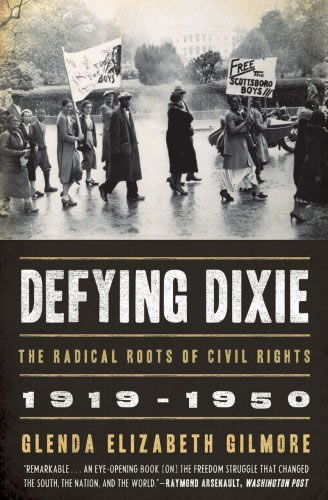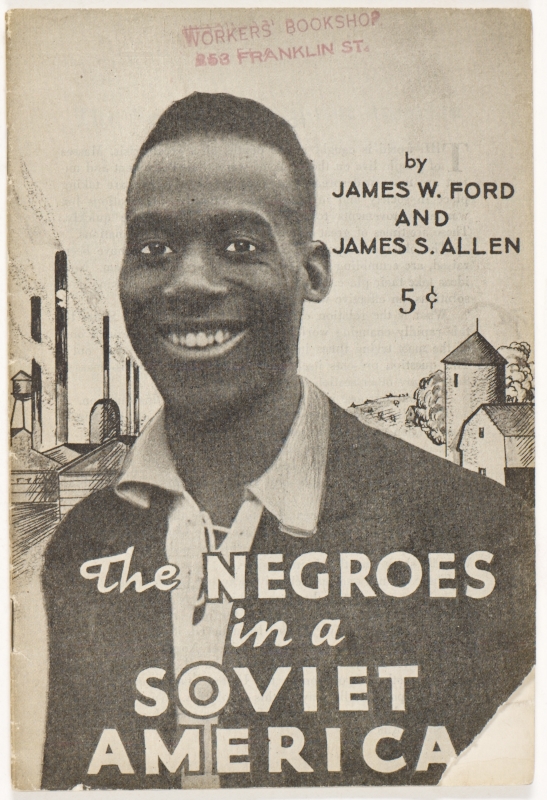
The New York Times Book Review on 10 February 2008, "POLITICS ISSUE: Pathfinders," by Maurice Isserman:
The South, as its great historian C. Vann Woodward once noted, developed into the United States’ “most distinctive region.” Among its distinctions — bound up with but outlasting its peculiar institution of chattel slavery — were white Southerners’ preoccupations with human limitations, guilt and evil. Not for them the optimistic creed or “dream of perfection” associated with their Northern brethren. In that sense, Woodward argued, the South’s outlook was “a thoroughly un-American one.”

Which brings us to the central irony underlying “Defying Dixie: The Radical Roots of Civil Rights, 1919-1950,” by Glenda Gilmore, a native North Carolinian and the Peter V. and C. Vann Woodward professor of history at Yale University. In the early to mid-20th century, Gilmore argues, it was primarily individuals and groups judged “un-American” by their contemporaries who took on the daunting task of bringing the South in line with the American “dream of perfection” — at least insofar as perfection could be measured by adherence to the promise of equal protection before the law. In a wide-ranging narrative that moves from Chicago to Moscow to Chapel Hill, N.C. (where Gilmore tends to linger affectionately), she introduces scores of dedicated, colorful and sometimes eccentric dreamers and agitators. They include Communists and Socialists, preachers of the social gospel, disciples of Gandhi, prominent academics and impoverished millworkers who, although mostly forgotten today, prepared the way, she argues, for the better known civil rights advocates of the 1950s and 1960s.

As Gilmore acknowledges, she is not the first to explore the notion of the “long civil rights movement,” stretching back many years before Brown v. Board of Education and the Montgomery bus boycott. Readers of histories by John Egerton, Patricia Sullivan and others will recognize many of the characters and events discussed in Gilmore’s account. The return visit is mostly worthwhile thanks to her gift for vivid description and a number of interesting observations she offers along the way.

Two characters in her narrative particularly stand out. The first is Lovett Fort-Whiteman, a Dallas-born graduate of Tuskegee Institute who was one of the first blacks recruited into the American Communist Party. Dispatched soon afterward to Moscow as part of an official delegation, he lectured about race discrimination in the United States to an audience that included Joseph Stalin. In the style of many radicals of the era, he became a thorough Russophile: in Gilmore’s marvelous account, he walks down a street in a black neighborhood in Chicago greeting friends shortly after his return from his pilgrimage to Moscow, sporting a robochka — a Russian peasant blouse — as well as “knee-high felt boots and a small mustache.” Fort-Whiteman was instrumental in pushing American Communists to broaden their concept of class struggle to include the fight against racism. In the 1930s he moved permanently to Moscow, married a Russian woman and entertained black visitors who had come to see the vaunted Soviet experiment in action. Like many foreign Communists living in Moscow in that era, he ran afoul of the secret police, and died of starvation and mistreatment in a labor camp in 1939.

Pauli Murray came to a better end. Growing up in Durham, N.C., she early on developed a hatred for Southern segregation, fleeing to New York shortly after finishing high school. There she enrolled at Hunter College and graduated in 1933. Drawn into the city’s radical circles, she became, in turn, a Socialist, a pacifist and a feminist. In 1938, she applied to graduate school at the University of North Carolina at Chapel Hill. Her great-great-grandfather, a white doctor and congressman, had been a trustee in the antebellum era, but the family connection did her no good; as soon as the admissions office discovered she was black, they fired off a rejection. She then wrote directly to Frank Graham, the university’s president, who had earlier signed a statement protesting expulsion of Jewish students from German colleges. “How can Negroes,” she asked, “defend our institutions against the threats of Fascism and barbarism if we too are treated the same as the Jews of Germany?” The liberally inclined Graham was sympathetic but, bound by North Carolina’s segregationist statutes, decided he could do nothing to help her. Murray went on to earn a law degree at Howard University and played a pioneering role in applying Gandhian tactics of civil disobedience to desegregate restaurants in Washington during World War II. (That she was also a cross-dressing lesbian who wound up an Episcopal priest majkes her an even more interesting character.)
Murray’s comparison of Nazi anti-Semitism to the Southern Jim Crow system was no ideological shot in the dark. Gilmore notes that in the 1930s, black Americans were more likely than whites to be alert to the Nazi threat. Civil rights proponents held up a “Fascist mirror” to the South, shaming some Southern white moderates into speaking out against officially enforced discrimination in their own backyard. Racial injustice began to be seen not merely as a matter of isolated acts of irrational prejudice but as a systematic denial of human rights and an affront to the nation’s official creed of liberty and equality — that is, “thoroughly un-American.” In fostering a politics that linked antifascism abroad with antiracism at home, the “radical left” (including but not restricted to Communists) thus “redefined the debate over white supremacy and hastened its end.”

Glenda Elizabeth Gilmore, a native North Carolinian and the C. Vann Woodward Professor of History at Yale University, discusses her revealing new book, Defying Dixie: The Radical Roots of Civil Rights, 1919-1950, which looks at forgotten black and white southern activists, whose courageous work in the face of Jim Crow segregation laws, helped lay the foundation for the later civil rights movement.
That final point is crucial to Gilmore’s argument. Unfortunately her belief that radical activists of the 1930s and 1940s “hastened” the end of Jim Crow in the postwar era is more asserted than demonstrated. And without such demonstration, Pauli Murray notwithstanding, “Defying Dixie” becomes an exercise in radical antiquarianism, a series of disparate essays built around interesting personalities, the whole rather less than the sum of its parts. (source: New York Times Book Review)
Maurice Isserman teaches history at Hamilton College. He is the author of “If I Had a Hammer: The Death of the Old Left and the Birth of the New Left,” among other books.

No comments:
Post a Comment